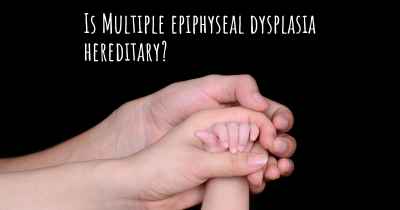How is Multiple epiphyseal dysplasia diagnosed?
See how Multiple epiphyseal dysplasia is diagnosed. Which specialists are essential to meet, what tests are needed and other useful information for the diagnosis of Multiple epiphyseal dysplasia

Diagnosis of Multiple Epiphyseal Dysplasia (MED)
Multiple Epiphyseal Dysplasia (MED), also known as Fairbank disease, is a genetic disorder that affects the development of the bones and joints. It is characterized by abnormalities in the growth plates, which are responsible for bone growth and development. MED can cause various symptoms, including joint pain, stiffness, and limited range of motion. Diagnosing MED involves a combination of clinical evaluation, imaging studies, and genetic testing.
Clinical Evaluation
The first step in diagnosing MED is a thorough clinical evaluation by a healthcare professional, typically a pediatrician, orthopedic surgeon, or geneticist. The doctor will review the patient's medical history, including any family history of bone or joint disorders. They will also perform a physical examination to assess the patient's joint mobility, look for any characteristic physical features associated with MED, and evaluate the presence of symptoms such as joint pain or stiffness.
Imaging Studies
Imaging studies play a crucial role in the diagnosis of MED. X-rays are commonly used to evaluate the bones and joints. The radiographic findings in MED may include:
- Delayed bone age: The bones may appear younger than expected for the patient's chronological age.
- Irregular epiphyses: The growth plates at the ends of the bones may be irregularly shaped or fragmented.
- Flattened vertebrae: The bones of the spine may appear flattened or irregular.
- Abnormal joint spaces: The spaces between the bones in the joints may be irregular or narrowed.
In addition to X-rays, other imaging modalities such as magnetic resonance imaging (MRI) or computed tomography (CT) scans may be used to provide more detailed information about the bones and joints.
Genetic Testing
Genetic testing is the definitive method for diagnosing MED. It involves analyzing the patient's DNA to identify specific mutations or changes in the genes associated with MED. The most common genes involved in MED are COMP (cartilage oligomeric matrix protein), COL9A1 (collagen type IX alpha 1 chain), COL9A2 (collagen type IX alpha 2 chain), and COL9A3 (collagen type IX alpha 3 chain).
The genetic testing can be performed using various techniques, including targeted gene sequencing, whole exome sequencing, or gene panel testing. These tests can identify specific mutations in the genes associated with MED, confirming the diagnosis.
Differential Diagnosis
It is important to differentiate MED from other conditions that may present with similar symptoms or radiographic findings. Some conditions that may be considered in the differential diagnosis of MED include:
- Achondroplasia
- Pseudoachondroplasia
- Stickler syndrome
- Metaphyseal chondrodysplasia
- Multiple osteochondromas
Genetic testing and careful evaluation of the clinical and radiographic findings can help distinguish MED from these other conditions.
Conclusion
Diagnosing Multiple Epiphyseal Dysplasia involves a comprehensive approach that includes clinical evaluation, imaging studies, and genetic testing. The clinical evaluation helps assess the patient's symptoms and physical features, while imaging studies provide valuable information about the bones and joints. Genetic testing is the definitive method for confirming the diagnosis by identifying specific mutations in the genes associated with MED. Proper diagnosis is essential for appropriate management and treatment of MED, as it allows for early intervention and support for affected individuals.
Posted Mar 4, 2017 by Sarah 2000
Posted Nov 19, 2017 by Daniela Corrêa De 2500








